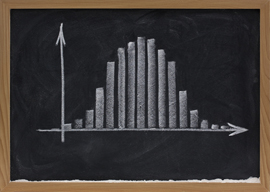
June 07, 2017

Source: BIgstock
Since the 1990s, whites have fallen in love with an extension of self-esteem theory called “stereotype threat”: Researchers can sometimes induce blacks to score worse on meaningless, low-stakes tests than they had previously scored on high-stakes tests (such as the SAT) by telling them that they are expected to do badly on this pointless test.
However, stereotype threat doesn”t replicate well. U. of Chicago economist John List said a half decade ago:
I think what has happened is, a few people found this result early on and now there’s publication bias. But when you talk behind the scenes to people in the profession, they have a hard time finding it. So what do they do in that case? A lot of people just shelve that experiment; they say it must be wrong because there are 10 papers in the literature that find it. Well, if there have been 200 studies that try to find it, 10 should find it, right?
My guess for why some researchers get the desired stereotype-threat results and others don”t is that the experiments are carried out using meaningless tests. (No institutional review board would allow researchers to try to induce poorer performance on a high-stakes test like the LSAT.) Some researchers succeed in signaling to the appropriate test-takers through body language, intonation, or whatever that there is no reason for them to try hard on this unimportant test, while others don”t.
The evidence from sports suggests that the world would adjust to awareness of genetic differences in racial average IQs with equanimity.
The idea that the races differ hereditarily in sports talents is no longer terribly controversial. Indeed, outgoing President Obama, having bought the human-biodiversity-woke book The Sports Gene by David Epstein as a Christmas present to himself, frequently lectured puzzled interlocutors about the importance of genetic diversity in sports.
(Of course, it very much helps Americans grasp that the increasing evidence for the existence of human genetic diversity impacting sports is not some apocalyptic event that there are popular sports that blacks tend to be better at.)
Over the past couple of generations, American whites have largely been squeezed out of much of a playing role in the NBA, causing some fans to lose interest. But the NBA remains a lucrative enterprise, with Steve Ballmer paying $2 billion to buy the star-crossed Los Angeles Clippers franchise from the besieged Donald Sterling in 2014.
Conversely, African-Americans have largely lost interest in baseball, a game in which distinctive black genetics are less advantageous than in basketball or football. But baseball is thriving, with last fall’s World Series the most watched and talked-about in years.
Likewise, whites are slowly abandoning basketball and football, with tall white guys focusing on making it as big-league pitchers. For example, the U. of Kentucky is a traditional basketball power, but this year UK’s SEC Pitcher of the Year is 6-foot-11-inch Sean Hjelle from White Bear Lake, Minn.
Similarly, strong white guys like Mike Trout, Bryce Harper, and Kris Bryant, all in the 230+ pound range that formerly would have concentrated on playing linebacker in football, are working on hitting homers.
In other words, the world hasn”t ended. Life goes on. People adjust.
So, if Charles Murray turning out to be right wouldn”t be the catastrophe that is widely assumed, might it help the commonweal?
If we applied the realism that we bring to sports to matters of public policy, such as education, we”d likely make more progress than we”ve been achieving over the past few decades, when most of the effort has been devoted to futile gap-closing efforts.
For example, instead of schools trying to boost black cognitive performance by one standard deviation while keeping whites from getting better, why not focus on improving all groups by a half standard deviation each? That seems fairer and far more feasible due to the phenomenon of diminishing marginal returns.
But instead, this simple goal never occurs to anybody.
Overall, the day after Murray were proved right would look just like the day before, because if Murray is right, then he is merely describing the world as it is.
After all, the reason college students try to beat up Murray is because they fear he is right.